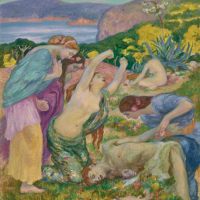44. RUPERT BUNNY

The myth of Venus and Adonis is widely known through numerous sources. Rupert Bunny, having left Australia in 1884 for Europe, would have encountered the story through famous paintings to be seen in London by Titian (1488/90-1576), who painted several versions, as well as various treatments by Rubens (1577-1640). There is also the poem by William Shakespeare. The story is recounted in Ovids Metamorphoses (Book X), although its origins are thought to be earlier. Bunnys painting of the subject is datable to 1917.
Adonis was a hunter, a mortal, known for his skill but also for his handsome appearance. Venus, the goddess of beauty, fell in love with him. In Titians famous version (Metropolitan Museum of Art, New York), Venus and Adonis are depicted as a couple. Adonis prepares to leave to hunt, and Venus entreats him to stay, fearing that he may come to harm. Like other depictions of the subject, the scene poignantly combines love and tragedy. Venus fears are realised. Adonis is killed in an encounter with a boar. The irony lies in duty over pleasure. Adonis sense of duty outweighs his love for Venus and causes him to leave her. This is the fulcrum of the narrative: how can one weigh up the reasons, the motivations, to leave, rather than spend time in the arms of a beautiful goddess? Venus grief upon discovering the body of her lover is the second act of this drama and the subject of Bunnys painting.
Bunny painted the subject as part of an extended series of Mythological Decorations. Like Titian, he intended the work to be a poesie and it confirms his longstanding belief in sensuality and the pleasures of repose and relaxation. And yet, his version painted during the First World War cannot be regarded without considering the enduring tragedy and daily reports of deaths of hundreds of young men in the saga unfolding on the Western Front.
Similarly, Bunnys interest in classical subjects did not mean he was disinterested in modern art. The links between his Mythological Decorations and the art of his time is most clear in comparing his work with the French painter Pierre Puvis de Chavannes (1824-1898). It was not only Bunny who responded to these classicising tendencies. Van Gogh (1853-1890) and Gauguin (1848-1903) also drew on the romantic mood and stillness of Puvis, as did Picasso (1881-1973) in his early paintings. Bunny was open to this engagement and notably so were his contemporaries, Gauguin, and Bonnard (1867-1947).
At this time, Bunnys work was recognised in London and Paris, and he continued to be the subject of successful exhibitions, building on the reputation he had established in the 1890s. His work had been acquired by the French state: three paintings were bought for the Luxembourg and a further nine works were acquired by museums outside Paris. Bunny made efforts to present his work to Australian audiences and although his Endormies had been bought by the Felton Bequest in 1911, it was only at the end of his life that his work became widely known in Australia. Having returned in 1933, Bunny slowly gained recognition and was duly rediscovered. Paul Haefliger, art critic for the Sydney Morning Herald confirmed this in proclaiming Bunny as the finest painter who ever lived in Australia.1
FOOTNOTES
1. Hughes, R., The Art of Australia, Penguin, Harmonsworth, 1970, p.109
Tim Abdallah